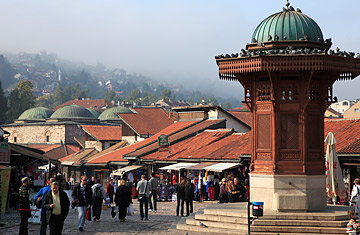
Pigeon Square in Sarajevo, September 24, 2010.

This post is in partnership with Worldcrunch, a new global-news site that translates stories of note in foreign languages into English. The article below was originally published in Le Temps.
This is one inventory of this city's past and present: among 6,000 local structures listed before 1992, 3,226 were damaged or destroyed during the war. Today, 80% of those structures have been protected or rebuilt.
Lidja Micic is proud of this progress in her native city. In her office, along the reddish river Miljacka, the head of Sarajevo's Heritage Protection office describes the bridges being soldered again, towers being rebuilt, churches and mosques that have acquired a new roof.
"The situation is much better today. Everything is written down in this," she says, pointing to a thick, handsome book that tracks the rebuilding efforts. Considering the economic crisis facing both the city and country of Bosnia and Herzegovina, one might wonder if the money wouldn't have been more useful spent elsewhere. Still, heritage is not to be taken lightly in this complicated city.
Is Sarajevo finally itself again? That is a question every tourist wonders upon returning to "the Balkans' Jerusalem". The pictures of snipers bombing the city from surrounding hills, of the burning library, are untarnished in the collective memory of the West. The media coverage stopped with the 1995 Dayton Peace agreement, a cease-fire that has held for nearly 16 years, but never meant to stand as the new country's founding document. If the media coverage during the 45-month siege of Sarajevo was strong, not much has followed.
And indeed, the city was born again. Little by little, bulldozers took away the junk so the rebuilding could begin of a city that now counts 310,000 residents. The old Bascarsija Ottoman neighborhood has been preserved, the Markale market, twice bombed, was rebuilt, and in the historic district the infamous "Sarajevo roses", those flower-shaped marks left by shells exploding on the concrete, are rare. Along the main road, the outdoor cafés, always crowded in the summer, can easily compete with French or Italian establishments.
Mango, Swatch, Adidas... names of big international firms have opened stores in the main street of the city, with the same merchandise as in Europe and at the same prices. The BBI, a shiny shopping centre, welcomes prestigious clients, though alcohol is forbidden because investors come from the Persian Gulf. The coming headquarters of Al Jazeera for the Balkans will be built in Sarajevo. Meanwhile, the big historic mosques and the Orthodox cathedral have regained all their charms, parks are clean, the chess players have taken back center stage. And the tourists are indeed coming back.
